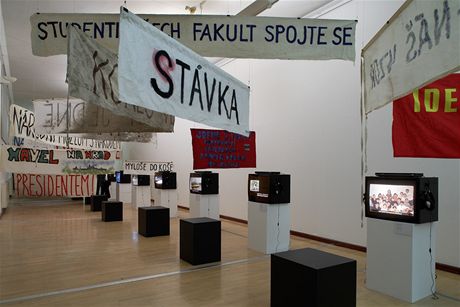 Více než dvouletý umělecký výzkum proměn společností, které přešly od totalitního k demokratickému uspořádání, vyvrcholil výstavou uspořádanou Galerií hlavního města Prahy a iniciativou tranzit a nazvanou Monument transformace.
Více než dvouletý umělecký výzkum proměn společností, které přešly od totalitního k demokratickému uspořádání, vyvrcholil výstavou uspořádanou Galerií hlavního města Prahy a iniciativou tranzit a nazvanou Monument transformace.VÍCE ZDE
 Více než dvouletý umělecký výzkum proměn společností, které přešly od totalitního k demokratickému uspořádání, vyvrcholil výstavou uspořádanou Galerií hlavního města Prahy a iniciativou tranzit a nazvanou Monument transformace.
Více než dvouletý umělecký výzkum proměn společností, které přešly od totalitního k demokratickému uspořádání, vyvrcholil výstavou uspořádanou Galerií hlavního města Prahy a iniciativou tranzit a nazvanou Monument transformace.
 „V těchto volbách jde o masivní útok před listopadových sil…, o pokus levice převzít moc, možná i ústavní“ – hlásají komentátoři například MfD. Bohumil Pečinka, novinář, který už od poloviny 90. let vede záslužný boj proti převaze morálního kýče v české politické kultuře, napsal: V očekávání předčasných voleb do Poslanecké sněmovny v říjnu 2009 se vytváří nejfalešnější předvolební aranžmá, jaké polistopadová politika zažila.
„V těchto volbách jde o masivní útok před listopadových sil…, o pokus levice převzít moc, možná i ústavní“ – hlásají komentátoři například MfD. Bohumil Pečinka, novinář, který už od poloviny 90. let vede záslužný boj proti převaze morálního kýče v české politické kultuře, napsal: V očekávání předčasných voleb do Poslanecké sněmovny v říjnu 2009 se vytváří nejfalešnější předvolební aranžmá, jaké polistopadová politika zažila.
Myslím, že:
1. Fuss přesně upozorňuje na "holo"klišé a "holo"kýč, tedy to, co se stalo z nacistického vyvražďování židů v obraze, který masám podává popkultura (zde filmy). Zvěrstva nebyla zřejmě dost špinavá, aby nebylo třeba je přikašírovat, přifukovat a činit ještě obludnějšími!? Jakoby fakta sama nebyla dost schmutzig. Jakmile někdo "stvoří" něco "o holokaustu", aspiruje tím na rovnou na uměleckou cenu v tom kterém oboru; pokud to "dílo" za moc nestojí, stává se alespoň nekritizovatelným. Tvůrce je přece "angažovaný" na správné straně, tak bacha na něj.
2. Argument, ... "Snaha převést současné utrpení Palestinců na minulé utrpení Židů je scestná – jedná se o dvě výrazně odlišné tragédie ..." považuji za lichý. Respektive, jistěže nelze tvrdit, že "je to totéž." Není, je jiná doba. Jenže sionistická propaganda stojí a padá právě na tom, že směšuje někdejší oběti antisemitismu a nynější Izraelce provádějící "obranně-preventivní" akce na území Palestiny i mimo ně. Z toho plyne sionistický absolutní nárok na nekritizovatelnost počínání Izraelců. Jenže jak uniknout nutkavé paralele, že pokud se někdo důsledně desítky let chová jako nacista, asi to bude svým způsobem nacista?
3. Mimochodem: David Duke. Nerozumím argumentaci J. Čulíka: "Některé věci se tolerovat nedají, reklama nereklama. Spíš mám dojem, že veškerý mediální shon kolem Duka je tzv. "jednodenní zázrak". Za týden o něm nebude nikdo vědět." O tom, co budeme vědět za týden, přece nerozhoduje význam věci, ale média! Pokud propagandě na problému záleží, zaručeně vám na něj nedá zapomenout. Kupte si třeba každou sobotu Mladou frontu nebo Lidové noviny a spočítejte si slova s kořenem "žid...", nebo "holokaust..." Nezapomenete! Svoboda slova buď je nebo není. V USA tu svobodu alespoň Duke má, jiní o ní už přicházejí nebo přišli. Jestli zrovna tohle je pozitivní trend?
A zde je rozhovor s Dukem. To by se asi nemělo tisknout, že?
P.S: Velmi bych se přimlouval za vydání "holodogmat", kde by bylo jasně stanoveno, o čem je za všech okolností zakázáno diskutovat - abychom nenarazili.